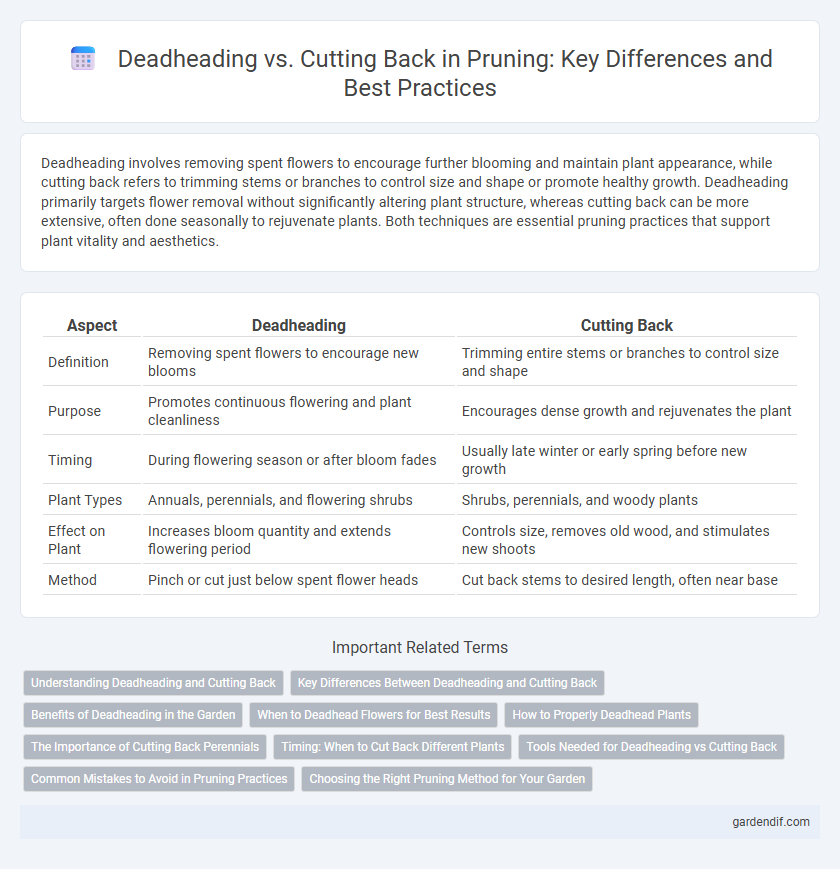
Deadheading vs cutting back Illustration
Deadheading involves removing spent flowers to encourage further blooming and maintain plant appearance, while cutting back refers to trimming stems or branches to control size and shape or promote healthy growth. Deadheading primarily targets flower removal without significantly altering plant structure, whereas cutting back can be more extensive, often done seasonally to rejuvenate plants. Both techniques are essential pruning practices that support plant vitality and aesthetics.
Table of Comparison
| Aspect | Deadheading | Cutting Back |
|---|---|---|
| Definition | Removing spent flowers to encourage new blooms | Trimming entire stems or branches to control size and shape |
| Purpose | Promotes continuous flowering and plant cleanliness | Encourages dense growth and rejuvenates the plant |
| Timing | During flowering season or after bloom fades | Usually late winter or early spring before new growth |
| Plant Types | Annuals, perennials, and flowering shrubs | Shrubs, perennials, and woody plants |
| Effect on Plant | Increases bloom quantity and extends flowering period | Controls size, removes old wood, and stimulates new shoots |
| Method | Pinch or cut just below spent flower heads | Cut back stems to desired length, often near base |
Understanding Deadheading and Cutting Back
Deadheading involves removing spent flowers to encourage continuous blooming and prevent seed formation, especially important for annuals and perennials like roses and petunias. Cutting back refers to trimming stems or branches to control plant size, promote healthy growth, or prepare plants for seasonal changes, commonly applied to shrubs and perennials such as lavender and hydrangeas. Mastering the timing and techniques of deadheading and cutting back optimizes plant health, flowering duration, and overall garden aesthetics.
Key Differences Between Deadheading and Cutting Back
Deadheading involves removing spent flowers to encourage new blooms and extend the flowering period, while cutting back refers to trimming back the entire plant or stems to control size and promote healthy growth. Deadheading targets only the faded blossoms, preserving the plant's foliage and overall structure. Cutting back is typically more intensive, often done seasonally, and can rejuvenate overgrown or leggy plants, enhancing their shape and vigor.
Benefits of Deadheading in the Garden
Deadheading promotes continuous blooming by removing spent flowers, encouraging plants to allocate energy toward new growth instead of seed production. This practice enhances garden aesthetics, maintaining vibrant and healthy plants throughout the growing season. Additionally, deadheading reduces the risk of disease by improving air circulation around the plant and preventing fungal infections often associated with decaying blooms.
When to Deadhead Flowers for Best Results
Deadhead flowers promptly after blooms fade to encourage continuous flowering and prevent seed formation. Timing varies by species, but generally, removing spent blooms every 1-2 weeks during the growing season maximizes garden vitality. Consistent deadheading improves plant appearance and promotes stronger, more abundant blooms compared to cutting back, which is typically reserved for end-of-season maintenance.
How to Properly Deadhead Plants
Properly deadheading plants involves removing spent flowers just above the first set of healthy leaves or buds to encourage new blooms and prevent seed formation. Use clean, sharp pruning shears to make precise cuts without damaging the stem, promoting vigorous growth and extended flowering. Regular deadheading maintains plant aesthetics and health by redirecting energy from seed production to flower development.
The Importance of Cutting Back Perennials
Cutting back perennials is essential for promoting healthy growth and enhancing flowering in the following season. Unlike deadheading, which removes spent blooms to encourage continuous blooming, cutting back involves trimming the entire plant to stimulate new shoots and prevent disease. Proper cutting back techniques improve air circulation, reduce pests, and help maintain the plant's overall vigor and structure.
Timing: When to Cut Back Different Plants
Timing for cutting back plants varies by species, with herbaceous perennials typically pruned in late fall or early spring to encourage healthy growth, while shrubs often require cutting back in late winter before new growth begins. Deadheading spent flowers should be done continuously throughout the blooming season to extend flowering and prevent seed formation. Understanding specific plant cycles ensures optimal pruning results and maximizes plant health and appearance.
Tools Needed for Deadheading vs Cutting Back
Deadheading requires precision tools such as hand pruners or scissors to remove spent flowers without damaging new growth, promoting continuous blooming. Cutting back involves sturdier tools like loppers or pruning saws to trim larger branches or stems, encouraging healthy regrowth and plant shape maintenance. Proper tool selection ensures clean cuts, reduces plant stress, and improves overall garden health.
Common Mistakes to Avoid in Pruning Practices
Deadheading removes spent flowers to encourage continuous blooming, while cutting back involves trimming stems to promote plant health and shape. Common mistakes include cutting back too severely during blooming, which halts flower production, and confusing deadheading with pruning, leading to unnecessary removal of healthy foliage. Avoid cutting into old wood on plants that do not regenerate well from it, as this can cause dieback and reduce growth.
Choosing the Right Pruning Method for Your Garden
Deadheading targets spent blooms to encourage continuous flowering and prevent disease, ideal for annuals and perennials with showy blossoms. Cutting back involves trimming stems and branches to rejuvenate growth or shape the plant, often used for shrubs and perennials after blooming. Selecting the correct method depends on plant type, growth stage, and desired garden aesthetics to maximize health and visual appeal.
Deadheading vs cutting back Infographic

 gardendif.com
gardendif.com